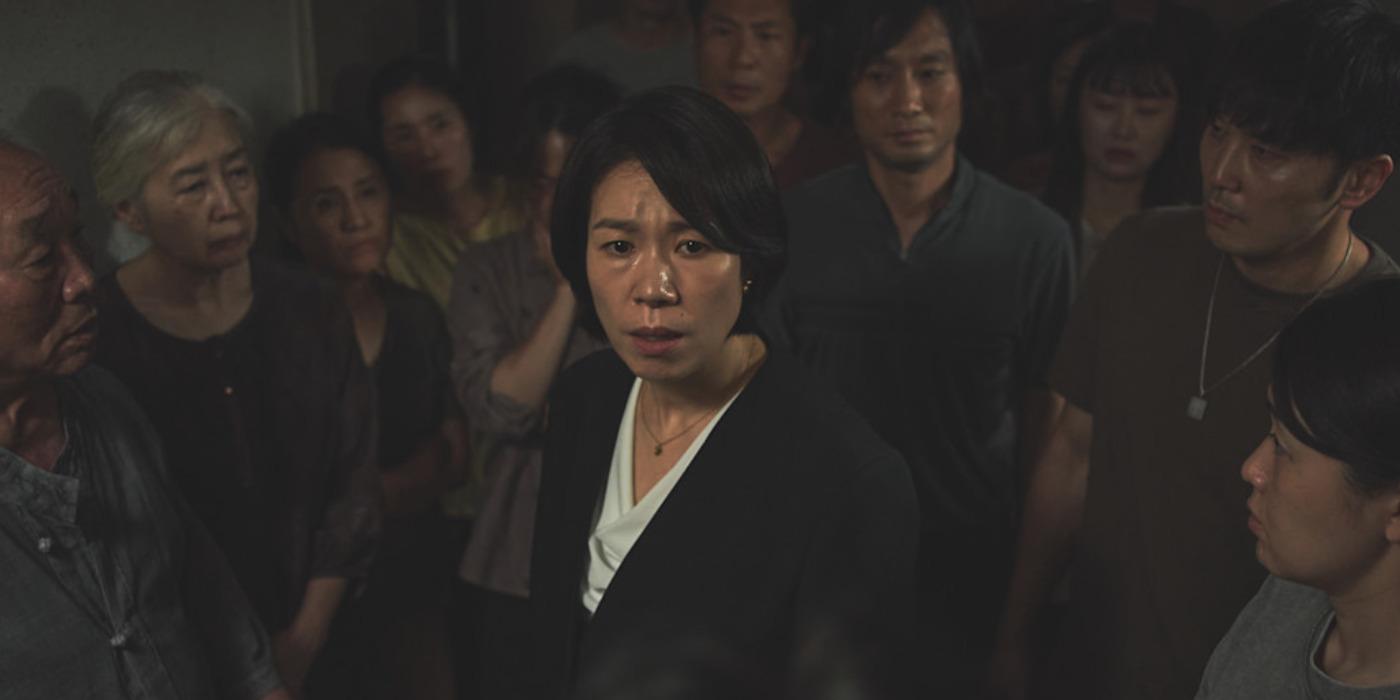Originally titled ’84 Jegopmiteo,’ ‘Wall to Wall’ is a South Korean thriller drama that takes an otherwise mundane irritation and turns it into a matter of life and death. Directed by Kim Tae-joon and Sharon S. Park, the Netflix film revolves around Woo-sung, who has successfully achieved his dreams of being a homeowner. Nonetheless, the mounting bills amidst a tumultuous real estate market and the incessant neighbourly noise threaten to drive him toward ruin. Fortunately, the apartment-wide disturbance also ticks off another resident, Jin-ho, the protagonist’s upstairs neighbor.
Consequently, the duo is prepared to look into the menacing truth that the apartment and its cold, calculating Resident Representative Eun-hwa are hiding underneath all the noise. Woo-sung’s narrative operates on a fairly grounded premise. His story suffers through the conflict of complications naturally associated with homeownership, like sky-high debts, rough market trends, and neighborly disputes. Even so, these prosaic elements culminate to create a tense thriller that is bound to hit home for some viewers. Consequently, the origins of such relatable and realistic narrative remain worth exploring.
Wall to Wall Reaps Inspiration From Kim Tae-joon’s Real-Life Experiences
‘Wall to Wall’ remains a relatively realistic story that mines inspiration from a number of off-screen instances. The most notable one remains writer and co-director Kim Tae-joon’s personal anecdote that compelled him to tackle the project in the first place. The filmmaker, known for his well-received debut film ‘Unlocked’ (originally titled ‘Seumateuponeul Tteoreotteuryeosseul Ppuninde’), underwent a distinct, almost universally relatable experience. While working on the film, he encountered terrible interfloor noise. Nonetheless, despite the likely grating circumstances, Kim decided to look at the situation from an artist’s perspective. During a press conference in Seoul, he discussed the situation and how it went on to inspire his sophomore directorial project.

“I was trying to overcome the stressful situation by trying to look at it positively, like, at least I can write something from this experience.” Naturally, as the project became more and more fleshed out, it started touching upon various other social issues associated with the central topic. In exploring the reality of interfloor noise and its effect on the psyche of an individual, Kim, alongside his co-director Sharon S. Park, created a tale that highlighted the nuances of the experiences of the younger generation. Consequently, narrative and thematic elements of debt, socio-economic hierarchy, and a raging desire for social justice inevitably folded into the tale. Ultimately, these inclusions strengthen the story’s connection to reality. Yet, the film retains an even stronger association off-screen.
Wall to Wall Explores the Reality of Noise Complaint-Related Violence in Seoul
The central conflict within ‘Wall to Wall’ stems from the real-life relevance of inter-floor noise, an intensely serious issue that plagues big cities. South Korea, in particular, has a population of 51 million, half of whom live in communal/apartment buildings, and neighborly noise remains a prevalent topic of conversation. The country’s capital city, Seoul, has seen multiple cases of violent altercations in the past few years, with this conflict at the center of their orbits. In January 2024, a homicide incident unraveled in South Gyeongsang Province’s Sacheon city. Reportedly, the suspect, a man in his 50s, was found to have attacked and killed the victim, his neighbor, over some noise disputes. The attack is believed to have happened on the staircase of their shared residential building. The suspect has claimed to resent his victim, a woman in his 30s, due to her tendency to loudly slam her front door.

In another instance, a deadly fire broke out in an apartment building in the Gwanak-gu area in April 2025. The fire killed multiple people, including the suspected arsonist, a resident of the residential complex. Although no firm confirmation has yet arrived, authorities believe the arson to be a result of the suspect’s continued argument with his upstairs neighbors regarding noise complaints. Both these instances share remarkable similarities with Kim and Park’s on-screen narrative, in which unrelenting noise drives an apartment full of residents to extremes.
Even though it’s unlikely that either of these incidents was employed as a direct, biographical inspiration for the film, they remain significant off-screen counterparts to the on-screen tale. Furthermore, while most conflicts of inter-floor noise in residential buildings (known in Korean as cheung-gan so-eum) don’t tend to take a violent turn, they still remain a highly prevalent social complication. In fact, authorities have introduced regulations to ensure interfloor noise doesn’t exceed a nationwide limit. Even so, the limit itself, and its almost exclusive application to only newly-built communal residences, has garnered some criticism over time. Ultimately, it’s evident that the subject matter and even parts of the narrative in ‘Wall to Wall’ retain a significant connection to a real-life social conflict.
Read More: Is Almost Family Based on a True Story?


